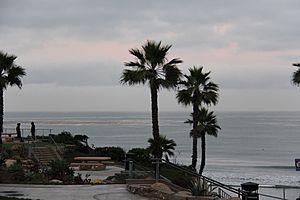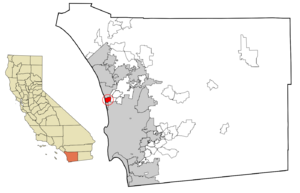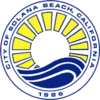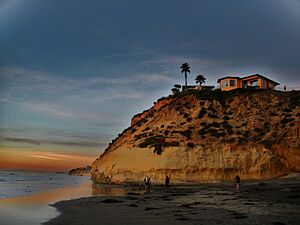Solana Beach, California facts for kids
Quick facts for kids
Solana Beach, California
|
|||
|---|---|---|---|

The Pacific Ocean as seen from Fletcher Cove Beach Park, photographed in October 2013
|
|||
|
|||

Location of Solana Beach within San Diego County, California
|
|||
| Country | |||
| State | |||
| County | |||
| Incorporated | July 1, 1986 | ||
| Area | |||
| • City | 3.52 sq mi (9.11 km2) | ||
| • Land | 3.41 sq mi (8.84 km2) | ||
| • Water | 0.10 sq mi (0.27 km2) 2.88% | ||
| Elevation | 72 ft (22 m) | ||
| Population
(2020)
|
|||
| • City | 12,941 | ||
| • Density | 3,676/sq mi (1,420.5/km2) | ||
| • Metro | SD-TJ: 5,105,768 | ||
| Time zone | UTC-8 (PST) | ||
| • Summer (DST) | UTC-7 (PDT) | ||
| ZIP code |
92075
|
||
| Area code(s) | 858 | ||
| FIPS code | 06-72506 | ||
| GNIS feature IDs | 1656633, 2411923 | ||
Solana Beach is a sunny city located in San Diego County, California. Its name, Solana, means "sunny side" in Spanish. This beach city is on the South Coast of California. In 2020, about 12,940 people lived in Solana Beach.
Contents
History of Solana Beach
The area where Solana Beach now stands has a long history. The first people to live here were the San Dieguitos. Later, the Kumeyaay people built a village called Kulaumai near the San Elijo Lagoon. During the time of the Spanish colonial rule, trails in this area went inland to avoid the marshy coast.
Early European Settlers
The first European family to settle here was the George H. Jones family in 1886. Before 1923, the area was known as Lockwood Mesa. Things started to change quickly after the Lake Hodges Dam was built between 1917 and 1918.
In 1918, the Santa Fe Irrigation District was created. This helped the land from Rancho Santa Fe to Solana Beach grow and become successful. The coastline from Solana Beach to Oceanside also saw a lot of development in the early 1920s.
Founding of Solana Beach
In 1922, Colonel Ed Fletcher, a local leader, bought 140 acres (0.57 km2) of land from George H. Jones. He wanted to develop the town of Solana Beach with his brother-in-law, Eugene Batchelder. To make it easier to get to the beach, they used strong water pressure to carve out the land. This created the area known as Fletcher Cove. It took one person three months using a fire hose and water from the Lake Hodges Dam. The beach officially opened on July 4, 1925, with a big celebration that included horse races.
Growth and Incorporation
Solana Beach grew steadily over the years. It saw big growth spurts after World War II and again in the late 1900s. In 1986, the community officially became the city of Solana Beach. That same year, the city held the funeral for famous actor Desi Arnaz.
In 2003, Solana Beach made national news. It became the first city in the continental United States to ban smoking on its public beaches. Many other California coastal towns have since followed this trend. Solana Beach was also the last coastal town in North San Diego County to ban alcohol on its beaches.
Eden Gardens Neighborhood
The neighborhood of La Colonia de Eden Gardens is one of the oldest parts of Solana Beach. It's also known as La Colonia or Eden Gardens. Mexican farmers created this community in the 1920s. They worked on large ranches in nearby Rancho Santa Fe and wanted their families close by. The name "Eden Gardens" was added later by a land developer for marketing. Many residents still call the area La Colonia.
Geography and Climate
Solana Beach is located right next to the Pacific Ocean on its west side. To the north is Cardiff-by-the-Sea, and to the south is Del Mar. The village of Rancho Santa Fe is to the east.
The city covers about 3.6 square miles (9.3 km2). Most of this area, about 3.5 square miles (9.1 km2), is land. The rest, about 0.1 square miles (0.26 km2), is water.
Coastal Bluffs
Before Solana Beach became a city, many large buildings were built on top of the sandstone bluffs along the coast. Geologists once thought these bluffs didn't change much. However, this was during a time with very few storms. Now, the city often deals with parts of the bluffs collapsing onto the beach. This can damage buildings above.
Weather in Solana Beach
Solana Beach has a mild climate. Here's a look at the average temperatures and rainfall:
| Climate data for Solana Beach, California | |||||||||||||
|---|---|---|---|---|---|---|---|---|---|---|---|---|---|
| Month | Jan | Feb | Mar | Apr | May | Jun | Jul | Aug | Sep | Oct | Nov | Dec | Year |
| Record high °F (°C) | 92 (33) |
94 (34) |
97 (36) |
103 (39) |
103 (39) |
105 (41) |
112 (44) |
109 (43) |
110 (43) |
105 (41) |
98 (37) |
90 (32) |
112 (44) |
| Mean daily maximum °F (°C) | 65 (18) |
65 (18) |
67 (19) |
68 (20) |
69 (21) |
71 (22) |
75 (24) |
77 (25) |
76 (24) |
73 (23) |
69 (21) |
66 (19) |
70 (21) |
| Mean daily minimum °F (°C) | 46 (8) |
47 (8) |
49 (9) |
52 (11) |
56 (13) |
60 (16) |
63 (17) |
64 (18) |
62 (17) |
57 (14) |
49 (9) |
45 (7) |
54 (12) |
| Record low °F (°C) | 25 (−4) |
27 (−3) |
32 (0) |
36 (2) |
41 (5) |
41 (5) |
52 (11) |
54 (12) |
49 (9) |
39 (4) |
29 (−2) |
26 (−3) |
25 (−4) |
| Average precipitation inches (mm) | 2.50 (64) |
2.31 (59) |
2.25 (57) |
0.81 (21) |
0.21 (5.3) |
0.09 (2.3) |
0.03 (0.76) |
0.11 (2.8) |
0.28 (7.1) |
0.40 (10) |
1.03 (26) |
1.35 (34) |
11.39 (289) |
Population of Solana Beach
| Historical population | |||
|---|---|---|---|
| Census | Pop. | %± | |
| 1970 | 5,023 | — | |
| 1980 | 13,047 | 159.7% | |
| 1990 | 12,962 | −0.7% | |
| 2000 | 12,979 | 0.1% | |
| 2010 | 12,867 | −0.9% | |
| 2020 | 12,940 | 0.6% | |
| U.S. Decennial Census | |||
The population of Solana Beach has stayed fairly steady over the past few decades. In 2020, the city had 12,940 residents. Most residents are White, with smaller groups of Asian, Black, and Native American people. About 15% of the population is Hispanic or Latino.
Economy
Solana Beach has a lively economy, especially known for its unique shopping and entertainment areas.
Cedros Design District
The Cedros Design District is a popular spot in Solana Beach. It has over 85 art galleries, antique shops, boutiques, and cafes. It's a great place to find unique items and enjoy local art.
The Design District also hosts the Solana Beach Farmers Market every Sunday. Here, you can find fresh flowers, baked goods, and organic fruits and vegetables. Another famous place on Cedros Avenue is the Belly Up, a live music venue that has been open since 1974.
Local Businesses
Solana Beach is also home to Nisus Software. This company develops the Nisus Writer, a popular word processor for Apple Macintosh computers.
Arts and Culture
Solana Beach loves to celebrate with its community.
Fiesta Del Sol
For over 40 years, the city has hosted a free annual event called Fiesta Del Sol. This two-day festival is full of activities for kids, delicious food, and performances by local entertainers. It includes interactive games, rides, and lots of fun for everyone.
Concerts at the Cove
During the summer, Solana Beach also has a free concert series. These "Concerts at the Cove" are held at Fletcher Cove Park, offering a beautiful outdoor setting for live music.
Education
Students in Solana Beach attend schools in two main districts: the Solana Beach School District and the San Dieguito Union High School District.
High Schools
- Canyon Crest Academy
- San Dieguito Academy
- Torrey Pines High School
- Santa Fe Christian Schools (a private school for K-12)
Middle Schools
- Earl Warren Middle School
- Saint James Academy
Elementary Schools
- Skyline Elementary School
- Solana Vista Elementary School
- Saint James Academy
Transportation
Getting around Solana Beach and to other cities is easy. The Solana Beach Transit Center is a hub for train services.
- Amtrak's Pacific Surfliner train stops here, connecting Solana Beach to other cities along the coast.
- The Coaster is a commuter rail service that also stops at the transit center, helping people travel within the San Diego area.
- Interstate 5 is a major freeway that runs through Solana Beach, making it easy to drive to nearby communities.
Notable People
Many interesting people have lived in Solana Beach, including:
- George Brent, an actor
- Jim Dennis, a Hall of Fame harness racing driver
- Patrick J. Hannifin, a United States Navy Vice Admiral
- Patti Page, a famous singer
- Lil Rob, a rapper
See also
 In Spanish: Solana Beach para niños
In Spanish: Solana Beach para niños





